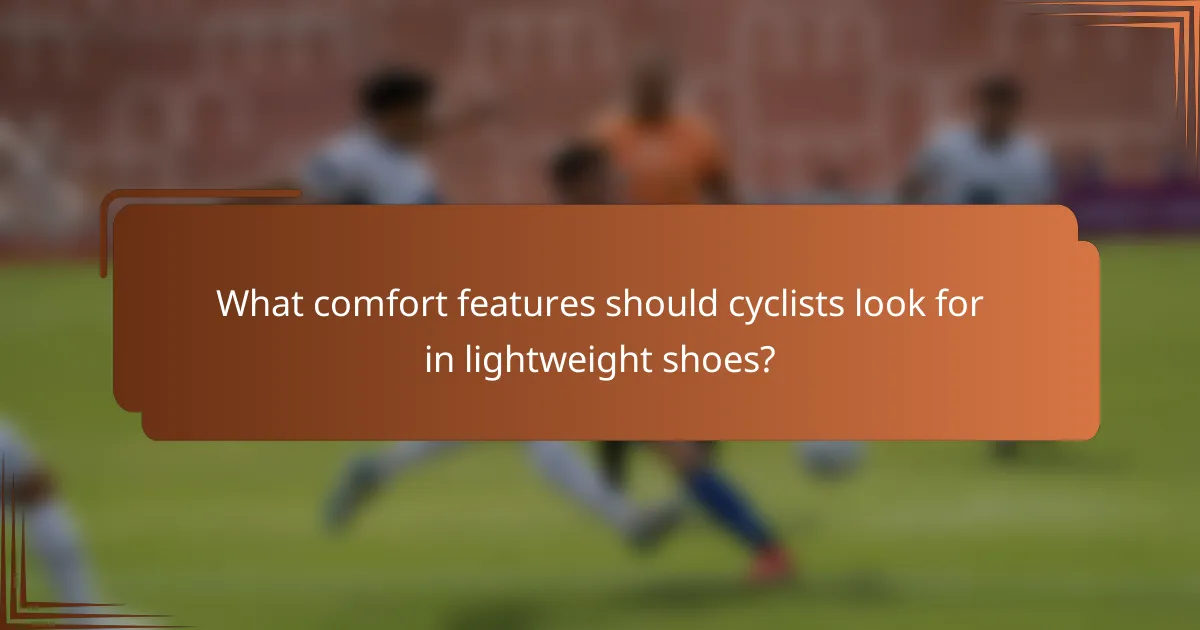Lightweight cycling shoes significantly enhance performance by reducing weight and improving power transfer. They offer durability through high-quality materials and weather-resistant properties. Comfort features like breathability and cushioning ensure an enjoyable ride. Understanding these aspects helps cyclists make informed choices for optimal performance.

What are the key performance enhancements of lightweight cycling shoes?
Lightweight cycling shoes enhance performance through reduced weight, improved power transfer, and enhanced breathability. These shoes typically feature stiff soles that maximize energy efficiency, allowing cyclists to maintain speed with less effort. Additionally, advanced materials offer durability while maintaining a lightweight profile. Comfort features such as moisture-wicking liners further enhance the overall riding experience.
How do lightweight materials affect cycling efficiency?
Lightweight materials significantly enhance cycling efficiency by reducing energy expenditure. Lightweight cycling shoes improve speed and agility, allowing cyclists to maintain higher performance levels. These shoes often feature breathable fabrics and advanced cushioning, contributing to overall comfort during long rides. The reduction in weight can lead to less fatigue, enabling cyclists to ride longer distances without compromising performance.
Which design features contribute to improved aerodynamics?
Design features that enhance aerodynamics in lightweight cycling shoes include streamlined shapes, minimal seams, and lightweight materials. These elements reduce drag and improve performance. Specialized outsoles and ventilation systems further optimize airflow, contributing to overall efficiency.
What role does sole stiffness play in power transfer?
Sole stiffness significantly enhances power transfer in lightweight cycling shoes. A stiffer sole minimizes energy loss during pedaling, maximizing efficiency. This characteristic allows for better responsiveness and acceleration, which are crucial for competitive cycling performance. Additionally, the right balance of stiffness and comfort can improve overall rider endurance, making it a vital attribute in shoe design.

How do durability features impact the lifespan of cycling shoes?
Durability features significantly enhance the lifespan of cycling shoes by ensuring they withstand wear and tear. High-quality materials, such as reinforced uppers and durable soles, resist abrasion and extend usability. Shoes designed with weather-resistant properties maintain performance in varying conditions. Regular maintenance, like cleaning and proper storage, further contributes to longevity. Investing in shoes with robust durability features can yield better long-term value for cyclists.
What materials are known for their longevity in cycling shoes?
Materials known for their longevity in cycling shoes include synthetic leather, mesh, and carbon fibre. Synthetic leather offers durability and water resistance, while mesh enhances breathability. Carbon fibre contributes to lightweight strength, ensuring long-lasting performance.
How do construction techniques influence wear and tear?
Construction techniques significantly affect the wear and tear of lightweight cycling shoes. Advanced methods enhance durability, ensuring shoes withstand rigorous use. Techniques such as seamless construction reduce stress points, leading to longer-lasting performance. Additionally, the choice of materials impacts comfort and resilience, with high-quality composites resisting abrasion better.
Which brands are recognized for their durable cycling shoes?
Brands recognized for durable cycling shoes include Shimano, Sidi, Giro, Specialized, and Fizik. These brands consistently emphasize performance enhancements, durability, and comfort features in their designs. Shimano shoes, for instance, are known for their robust construction and lightweight materials, making them popular among serious cyclists. Sidi offers unique custom fit options, enhancing comfort during long rides. Giro’s shoes often feature advanced ventilation systems for breathability. Specialized focuses on ergonomic designs that support foot health, while Fizik combines style with performance, appealing to competitive cyclists.

What comfort features should cyclists look for in lightweight shoes?
Cyclists should prioritize breathability, cushioning, and flexibility in lightweight shoes. Breathable materials enhance ventilation, keeping feet cool during rides. Adequate cushioning provides comfort over long distances, reducing fatigue. Flexibility allows for natural foot movement, improving pedalling efficiency. Additionally, lightweight construction minimizes drag, enhancing overall performance.
How does fit affect overall riding comfort?
Fit significantly affects overall riding comfort by ensuring proper alignment and support. A well-fitted lightweight cycling shoe enhances power transfer and reduces fatigue. The shoe’s design, including arch support and toe box space, directly influences comfort during long rides. Additionally, materials that conform to the foot shape can minimize hotspots and blisters.
What cushioning technologies enhance comfort during long rides?
Cushioning technologies like EVA foam, gel inserts, and carbon fibre plates enhance comfort during long rides. These materials provide shock absorption, reduce fatigue, and improve energy transfer. For instance, EVA foam offers lightweight support, while gel inserts adapt to foot shape for personalized comfort. Carbon fibre plates enhance performance by providing stiffness, optimizing power transfer. Together, these technologies ensure a comfortable ride over extended distances.
Which ventilation features help regulate temperature?
Lightweight cycling shoes regulate temperature through features like breathable mesh uppers, moisture-wicking linings, and ventilation ports. These attributes enhance airflow and moisture management, ensuring optimal comfort during rides. Breathable mesh uppers allow air circulation, while moisture-wicking linings draw sweat away from the foot. Ventilation ports provide additional airflow, reducing heat buildup.

What unique attributes distinguish premium lightweight cycling shoes?
Premium lightweight cycling shoes are distinguished by their advanced materials, precise fit, and superior breathability. These shoes often utilize carbon fibre soles for enhanced power transfer, making them unique in performance. Additionally, features like seamless construction reduce weight and increase comfort, setting them apart from standard models. Rarely, some premium options include customizable insoles for tailored support, further elevating the cycling experience.
How do custom-fit options enhance performance and comfort?
Custom-fit options significantly enhance performance and comfort in lightweight cycling shoes by ensuring an optimal fit. A precise fit minimizes energy loss during pedalling and reduces foot movement within the shoe, enhancing power transfer. Customization can also address individual foot shapes and pressure points, leading to increased comfort and reduced risk of blisters or injuries. Moreover, tailored features, such as arch support and cushioning, adapt to the rider’s unique needs, further improving overall cycling experience.
What innovative closure systems improve fit and ease of use?
Innovative closure systems like BOA dials and Velcro straps enhance fit and ease of use in lightweight cycling shoes. BOA dials allow for quick adjustments and a precise fit, while Velcro straps provide convenience and flexibility. These systems contribute to improved performance by ensuring optimal foot stability and comfort during rides.

Which rare features can elevate the cycling experience?
Lightweight cycling shoes can enhance the cycling experience through unique features like advanced breathability, specialized grip patterns, and customizable fit systems. These attributes contribute to improved performance and comfort during rides. For instance, shoes with integrated ventilation systems promote airflow, reducing heat buildup. Additionally, rare materials such as carbon fibre soles offer superior power transfer while maintaining low weight. Finally, shoes designed with adaptive lacing systems provide a personalized fit, ensuring optimal support and stability.
What advanced technologies are emerging in lightweight cycling shoes?
Advanced technologies in lightweight cycling shoes include advanced materials, innovative fastening systems, and enhanced cushioning. These features improve performance, increase durability, and provide superior comfort for cyclists.
1. Advanced Materials: Shoes utilize carbon fibre and synthetic blends for reduced weight and increased strength.
2. Innovative Fastening Systems: Technologies like BOA and Velcro allow for quick adjustments and secure fits.
3. Enhanced Cushioning: New foams and gel inserts offer better shock absorption and comfort during rides.
4. Breathability Features: Mesh panels and moisture-wicking liners enhance airflow and keep feet dry.
5. Custom Fit Options: Some brands offer heat-mouldable shoes for a personalized fit, improving overall performance.
How do limited edition models offer unique benefits?
Limited edition cycling shoes provide unique benefits through exclusive designs, advanced materials, and enhanced performance features. These models often utilize lightweight fabrics and specialized cushioning, improving speed and comfort. Additionally, they may incorporate rare technologies, such as carbon fibre soles, that increase durability and energy transfer. Collectors value their exclusivity, making them sought-after items in the cycling community.

What are the common mistakes to avoid when choosing lightweight cycling shoes?
Common mistakes when choosing lightweight cycling shoes include prioritizing weight over fit, neglecting the importance of durability, and ignoring comfort features. Many cyclists focus solely on the shoe’s lightweight design, which may compromise support and performance. Additionally, overlooking the shoe’s material quality can lead to premature wear. Lastly, failing to consider the right fit can result in discomfort during rides, impacting overall performance.
How can improper fit lead to discomfort or injury?
Improper fit of lightweight cycling shoes can lead to discomfort or injury by causing pressure points and instability. A shoe that is too tight can restrict blood flow, leading to numbness or pain. Conversely, a loose fit can result in blisters and lack of support, increasing the risk of falls or misalignment during cycling. Proper fit enhances performance and comfort, reducing injury risks.
What should cyclists consider when selecting shoe stiffness?
Cyclists should prioritize shoe stiffness based on their riding style and performance goals. Stiffer shoes enhance power transfer, ideal for competitive cyclists, while more flexible options offer comfort for casual riders. Stiffness ratings vary, generally ranging from 5 to 15, with higher values indicating increased rigidity. Additionally, consider the shoe’s weight and ventilation, as these factors impact overall comfort and endurance during rides.
Which maintenance tips can prolong the life of cycling shoes?
To prolong the life of cycling shoes, regularly clean them, store them properly, and replace worn components. Avoid exposing shoes to extreme temperatures and moisture.
1. Clean after every ride to remove dirt and sweat.
2. Use a shoe tree to maintain shape during storage.
3. Store in a cool, dry place away from direct sunlight.
4. Inspect and replace insoles when they wear out.
5. Check and tighten laces to prevent excess wear.
6. Avoid using them for non-cycling activities.